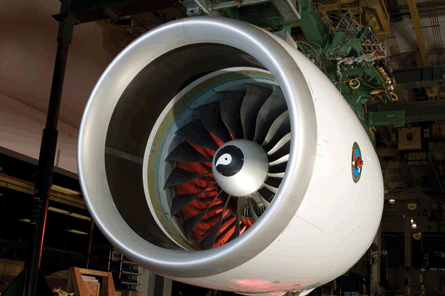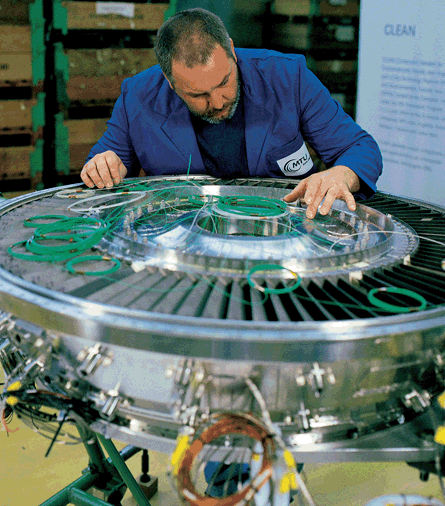It is tempting to assume that MTU Aero Engines is in a no-lose position as Airbus and Boeing consider their options for upgrading the powerplants on their respective A320 and 737 families. The German manufacturer and overhaul specialist is a shareholder in the International Aero Engines consortium, and also partners Pratt & Whitney in the PW1000G geared turbofan programme.
The IAE partners - P&W, Rolls-Royce, MTU and Japanese Aero Engine Corporation - are discussing how to address the competitive threat posed by the emergence of rival CFM International's Leap X advanced turbofan. If agreement is not reached, P&W could decide to go it alone, and offer the GTF programme (a project in which MTU also has a 15% stake).
However, Dr Anton Binder, MTU's executive vice-president for commercial programmes, is not taking anything for granted.
 |
|---|
© Pratt & WhitneyPratt & Whitney wants to get the geared turbofan on board the A320 and 737, but will it be offered via International Aero Engines? |
"Our preferred route to market is IAE, but we have to have a winning concept compared [with] the competitor's engine," says Binder. "In case we cannot come together, we have to look for alternative proposals. We are in a dialogue with the other shareholders, trying to investigate how we can make it happen."
ENHANCED A320
The IAE partners aim to reach a deal by the end of the first quarter to let Airbus achieve its goal of launching its enhanced A320 offering in time for July's Farnborough air show.
At the heart of the dilemma for the IAE partners is whether to adopt P&W's GTF architecture for any potential V2500 successor. R-R has consistently rejected the geared turbofan concept, preferring instead to research advanced two- and three-shaft turbofans, known as the RB282 and RB285, respectively.
"Our position always was that we were not dogmatic over two-shaft versus three-shaft," says Binder. "We have been analysing every concept. We concluded that the GTF provides the best value, technically, commercially and in terms of environment. Even today, we do not rule out thinking of other concepts, but you come to the conclusion that the GTF is ahead."
IAE chief executive Ian Aitken said at February's Singapore air show that the company's "intention" is to be on the re-engined A320. "We are the preferred route to the market [for the IAE partners]," he says. P&W also reiterated at the show its support for meeting the requirement via IAE.
 |
|---|
© MTUMTU is responsible for the PW1000G's high-speed, low-pressure turbine |
IAE is examining improvements to its V2500, as well as "a new technology package for a centreline engine", Aitken says.
"When Airbus has defined its performance criteria, our intention is to have an engine that meets that. We can pick the right configuration for the right application once Airbus solidifies its performance indication."
Airbus's chief salesman John Leahy said at Singapore that IAE "appears" to be planning to offer a "new generation" of P&W's GTF. P&W's commercial engines senior vice-president of sales, Bob Keady, declined to comment on any GTF development that IAE could undertake. However, he says that from P&W's perspective an advanced version of the engine could feature improvements to the core, such as newer-generation materials, and increased bypass and pressure ratios.
MTU's Binder says the partners "keep studying whether we could further improve the V2500", although Airbus's target of a 15% reduction in fuel consumption is challenging."If you want to achieve a step-change, you have to come up with a new architecture," he says.
The CFM Leap X concept introduces a new two-stage high-pressure turbine, plus some advanced materials that Binder claims are expensive, yet to be fully matured and could push up maintenance costs. Taking a similar approach for an IAE offering could present greater risks than would result from opting for a GTF-based architecture, he argues.
"If you do a two-shaft engine [rather than a geared turbofan], you are absolutely at the limit of what's possible," says Binder. "You are only marginally meeting the requirements."
By introducing the GTF's fan-speed reduction gearbox, "you do not need to go to the very limit of the turbomachinery", in terms of pressure ratios and operating temperatures, says Binder. He adds that the GTF has five fewer stages and 50% fewer aerofoils than the Leap X. The GTF's fan turns more slowly, which eases blade-off concerns, and enables a lighter fan casing to be used, he says.
CHEAPER MAINTENANCE
Airbus and Boeing are meanwhile looking for a double-digit reduction in maintenance costs. "We have a high confidence that we will achieve that with the GTF," says Binder.
"If you add everything together, we come up to a significant benefit for the GTF, but we are still open for each and every dialogue," he says. "What we definitely can offer to the customer is an engine that provides double-digit improvements in all areas. We cannot only offer that - we have proved it in enough tests."
 |
|---|
© MTU"Our preferred route to market is IAE, but we have to have a winning concept"Dr Anton BinderMTU executive vice-president commercial programmes |
Initial flight testing of the PW1000G GTF has been completed. The engine has been selected for the Mitsubishi MRJ regional jet and Bombardier CSeries airliner, and the first production engine for the latter programme is due to go to test in mid-July. The first engine for the MRJ is due to be run in October.
MTU is responsible for supplying the GTF's high-speed, three-stage low-pressure turbine and half of the powerplant's eight-stage high-pressure compressor - the same sections it supplies for the PW800 (although the latter has a conventional, rather than high-speed, LPT). The PW800, designed for long-range business jets, shares a largely common core with the PW1000G, but does not feature a geared fan.
MTU is responsible for assembling the A318's PW6000 under licence in Hanover, although the orderbook has run dry since the last of 34 engines was handed over to sole customer LAN Airlines of Chile. The line is being kept in "standby mode", says Binder. It is possible that MTU could seek a European assembly line for future derivatives of the GTF to supplement its PW6000 work, he adds.
WORKSHARE
"It depends on what the final [industrial] consortium is," says Binder. "We haven't split up the workshare so far, and MTU is not aggressively proposing to transfer assembly."
Late last year, MTU signed a deal with China's AVIC Commercial Aircraft Engine (ACAE) to "explore options for building a domestic aircraft engine industry", and announced it was setting up an office in Shanghai. ACAE plans to develop and manufacture engines for future airliners built by Comac.
Shortly afterwards, Comac selected CFM's Leap X as the sole powerplant for the 150-seat C919, which is to enter service in 2016. CFM says it intends to establish a local assembly line for the C919's Leap X1C engines.
Source: Flight International
















